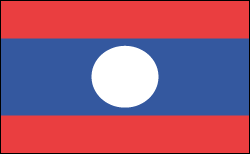Geography
A landlocked nation in Southeast Asia occupying the northwest portion of the Indochinese peninsula, Laos is surrounded by China, Vietnam, Cambodia, Thailand, and Burma. It is twice the size of Pennsylvania. Laos is a mountainous country, especially in the north, where peaks rise above 9,000 ft (2,800 m). Dense forests cover the northern and eastern areas. The Mekong River, which forms the boundary with Burma and Thailand, flows through the country for 932 mi (1,500 km) of its course.
Government
Communist state.
History
The Lao people migrated into Laos from southern China from the 8th century onward. In the 14th century, the first Laotian state was founded, the Lan Xang kingdom, which ruled Laos until it split into three separate kingdoms in 1713. During the 18th century, the three kingdoms came under Siamese (Thai) rule and, in 1893, became a French protectorate. With its territory incorporated into Indochina. A strong nationalist movement developed during World War II, but France reestablished control in 1946 and made the king of Luang Prabang constitutional monarch of all Laos. France granted semiautonomy in 1949 and then, spurred by the Viet Minh rebellion in Vietnam, full independence within the French Union in 1950.
In 1951, Prince Souphanouvong organized the Pathet Lao, a Communist independence movement, in North Vietnam. Viet Minh and Pathet Lao forces invaded central Laos, resulting in civil war. By the Geneva Agreements of 1954 and an armistice of 1955, two northern provinces were given to the Pathet Lao; the rest went to the royal regime. Full sovereignty was given to the kingdom by the Paris Agreements of Dec. 29, 1954. In 1957, Prince Souvanna Phouma, the royal prime minister, and Pathet Lao leader Prince Souphanouvong, the prime minister's half-brother, agreed to reestablishment of a unified government, with Pathet Lao participation and integration of Pathet Lao forces into the royal army. The agreement broke down in 1959, and armed conflict began anew.
In 1960, the struggle became a three-way fight as Gen. Phoumi Nosavan, controlling the bulk of the royal army, set up in the south a pro-Western revolutionary government headed by Prince Boun Oum. General Phoumi took Vientiane in December, driving Souvanna Phouma into exile in Cambodia. The Soviet bloc supported Souvanna Phouma. In 1961, a cease-fire was arranged and the three princes agreed to a coalition government headed by Souvanna Phouma.
Coalition Government Is Short-Lived
But North Vietnam, the U.S. (in the form of CIA personnel), and China remained active in Laos after the settlement. North Vietnam used a supply line (Ho Chi Minh Trail) running down the mountain valleys of eastern Laos into Cambodia and South Vietnam, particularly after the U.S.–South Vietnamese incursion into Cambodia in 1970 stopped supplies via Cambodian seaports.
An agreement reached in 1973 revived the coalition government. The Communist Pathet Lao seized complete power in 1975, installing Souphanouvong as president and Kaysone Phomvihane as prime minister. Since then, other parties and political groups have been moribund and most of their leaders have fled the country. The monarchy was abolished on Dec. 2, 1975, when the Pathet Lao ousted the coalition government and King Sisavang Vatthana abdicated.
The Supreme People's Assembly in Aug. 1991 adopted a new constitution that dropped all references to socialism but retained the one-party state. In addition to implementing market-oriented policies, the country has passed laws governing property, inheritance, and contracts.
One-Party Rule Continues as International Relations Improve
During the 1990s, the country began making more diplomatic overtures toward its neighbors. In 1995, the U.S. announced a lifting of its ban on aid to the nation. By most international estimates, Laos is one of the 10 poorest countries in the world. The subsistence farmers who make up more than 80% of the population have been plagued with bad agricultural conditions—alternately floods and drought—since 1993.
Since March 2000, Vientiane has been rocked by a series of unexplained blasts. The activity has been widely attributed to a group of Hmong tribesmen based in the north. The anti-Communist rebel group has been protesting the government's reluctance to embrace democratic reforms. Others attribute the bombs to rival factions in the government or military.
In Feb. 2002 parliamentary elections, 165 out of 166 candidates were members of the governing Lao People's Revolutionary Party. In 2006, Choummaly Sayasone became party secretary-general and president of Laos. First Deputy Prime Minister Bouasone Bouphavanh became prime minister.
See also Encyclopedia: Laos .
U.S. State Dept. Country Notes: Laos











